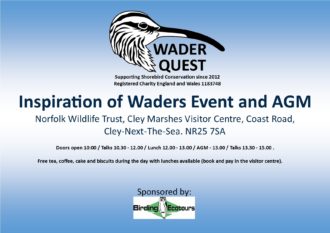News
Call for IWSG Small Grants 2019 closed
We have received a number of very relevant applications for the IWSG Small Grant 2019, and the reviewing process is starts now. All applicants are thanked for their submissions and during the next months we will be evaluating the proposals. The review team will try to find the best project for the grant, and a decision should be made no later than 1st May 2020. The applicant will be contacted directly, and it will announced on the website and on social media. IWSG Small Grant Committe.
John Edwards - Shirley, Solihull. West Midlands, UK
It's Christmas Day and I've been walking along a canal by the River Severn in UK and it reminded me of cannon netting in East Anglia with the Wash Wader Ringing Group back in the 1970's. Clive Minton was the lynchpin of the group, phoning people and getting them to travel a hundred miles at ungodly hours just because there was an exceptionally high tide - so the ringing was bound to be good. By chance I thought I'd check to see if there was anything on Wikipedia about him, as we'd lost touch when he moved to Australia. Very sad to see that he died in a road accident just over a month ago but pleased to see that he continued his ornithology and left a lasting legacy in both northern and southern hemispheres. An amazing guy whose enthusiasm was so infectious. ****************Thanks to Clive Minton from Nicola Crockford, UK
It was my great good fortune to have had the privilege of cannon netting with Clive and the VWSG on one occasion – in 1986 at Werribee Sewage Farm. I was over from New Zealand, with my boss at the time, Hugh Robertson of the New Zealand DSIR Ecology Division, to give a talk at the Royal Australian Ornithological Union about my undergraduate thesis work, from Durham University, on the feeding ecology of red knots at their spring staging site in Balsfjord, arctic Norway. I will always be grateful to Hugh for facilitating that opportunity. I treasure the vivid memories of meeting that legendary big bear of a man, seeing him in action, supported by the indomitable Pat, and of the camaraderie of sleeping in a sheep shearing shed, twinkling birds alongside the sting rays and processing the healthy haul of birds from beneath their hessian sacking. He had the gift of making one feel immediately part of the family – and a useful part at that. That feeling continued, whenever our paths crossed in later years, usually at the International Wader Study Group conferences. It was a real knack he had of making one feel valued – sending an encouraging email, often out of the blue, at just the right moment to help keep up the momentum with whatever wader conservation mission I was on at the time. And although I spent much less time with him than many, looking back, I realise that without him I would not have had my career, most of my career successes, my marriage, and many of my best friendships. This is because it seems to me that he created what – in my experience of global bird conservation – is the strongest, most collaborative community of bird scientists and conservationists in the world. Minton alumni have infiltrated the conservation world from local to global – from the heart of civil society groups counting and ringing birds year in year out, to Professors in the top Universities of the world, to national civil servants, to leaders in Convention Secretariats as well as across the NGO sector. It seems to me that he achieved this by infecting others with his passion and enthusiasm for birds, providing a model of leadership, by giving people a sense of empowerment, of having a useful role to play and by providing the field – and other conditions – for people to forge a profound team spirit as well as deep friendships that would last decades, through thick and thin. Clive set the modus operandi for the development of an incredibly strong community of common interest that has spread its tentacles across the planet. When Minton alumni meet, or even those who are a step or two removed from Clive, and without knowing such a link exists, there is an immediate common understanding and connection which needs no explanation, and can be the basis of very fruitful collaborations. I wonder if there is anyone in the world, who devotes a significant part of their life to migratory waders, who is more than a couple of steps removed from knowing Clive. Here are some examples of how, unbeknownst to me at the time, his influence has profoundly shaped my life since I was in my late teens, building on the early passion I developed for waders when a family friend would, year after year, take me along on the monthly wader counts of the Northumberland coast between Seahouses and Beadnell – close to where Clive began bird ringing at Monk’s House a quarter of a decade earlier.- In trying to decide at which University to read Zoology, I wrote to Durham, asking about what bird research they did, receiving a compelling reply from a certain Mike Pienkowski (Clive Minton Alumnus, CMA), outlining the wader work. I was sold! Maybe he bothered to reply to this random schoolgirl, because I was about to go on an expedition to Greenland, where he himself had led the famous 1974 expedition, the report of which I had read cover to cover.
- As a Durham undergraduate, I joined in the cannon-netting trips to the Tees Estuary alongside Mike, Nick Davidson and Peter Evans. This led to me being invited to their cannon netting expedition to Balsfjord in arctic Norway, to determine which population the large spring staging flock of red knots belonged to. It turned out that it was the same Nearctic birds that we had been ringing on the Tees! And my undergraduate thesis showed that the distribution of the knots did not match exactly the availability of their main food, Macoma baltica, due to avoidance of areas where they were more vulnerable to raptor predation. Red knots remain pretty much my favourite bird.
- It was in Balsfjord that I first met, and was inspired by, Jim Wilson (CMA), not realising the big influence on my later life of his joint discovery, with Mark Barter, of the importance of the Yellow Sea for migratory shorebirds.
- It was to give a talk on my undergraduate project that I first attended a WSG conference – in La Rochelle in 1985. The WSG’s uniquely friendly, welcoming, encouraging atmosphere – not least to a young female (we were much in the minority in those days) – further embedded my heart in the wader world, making me lifelong friends. I have subsequently been to many, many international ornithological and conservation conferences all over the world, but the IWSG Annual Conference is still always the best. Clive did a remarkable thing in establishing this organisation and its annual conference with such an inclusive ethos.
- When I graduated, my Aunt, who lived in Canada and had a friend who worked for the Canadian Wildlife Service (CWS), fixed up for me to volunteer with CWS. Given my love of waders – and experience in Greenland and arctic Norway, I was taken on by one Guy Morrison (CMA). That summer he took, me, alongside his regular field assistant, up to Rowley Island in the Foxe Basin of the eastern Canadian Arctic to help survey and ring breeding waders. I have never spent a more sublime few weeks. It cemented my love of the Arctic, and I would return twice more to the Foxe Basin with Guy. Not only would we gather lots of data on white-rumped sandpipers, my main study species, but we also had the immense thrill of finding a couple of knot nests.
- Guy’s boss at the time, Hugh Boyd, when he was Peter Scott’s head of research at The Wildfowl Trust, had lent Clive the rocket nets that resulted in the formation of the Wash Wader Ringing Group back in 1959. He became a close lifelong friend and mentor to me.
- It was no coincidence that my first job back in the UK, in 1987, was working at the Colchester office of the Nature Conservancy Council (NCC, UK statutory conservation agency), to designate the Blackwater, Colne and Crouch Estuaries as Ramsar Sites and EU Special Protection Areas (SPA) for the international importance for migratory waterbirds.
- Then Mike Pienkowski (CMA), working at the NCC HQ in Peterborough, summoned me to apply for a job at HQ to advise regional staff on combatting threats to SPAs and Ramsar Sites. This led me to be the government expert witness in the Public Enquiry against the Lionhope development on the Swale Estuary. Which we won, including through evidence resulting from Clive’s work.
- At the IWSG conference in Ipswich, UK in 1988 I met Bill Sutherland (CMA), then a lecturer at the University of East Anglia. We have now been together for 30 years, married for 23 of them, with two freshly fledged daughters. Without Clive there would have been no IWSG conference, nor participation of Bill in that one – he having done a PhD on oystercatcher feeding ecology after being a member of the Wash Wader Ringing Group.
- Having worked at the RSPB (BirdLife in the UK) since 1992, first at a UK level coordinating our work on wetland and upland birds (ie waders of course, with a smattering of birds of prey…), in 1997 I took on a new job at RSPB representing BirdLife International at European level in the various treaties relevant to species conservation. At the annual meeting of the Bern Convention on European Wildlife and Natural Heritage, I was made aware of a threat to the breeding waders of Iceland from government subsidised afforestation of the Icelandic lowlands. Wanting to avoid a repeat of the similar Flow Country cause celebre in the North of Scotland, which Mike P, then at the NCC, had helped lead the fight on, I instigated the opening of a Bern Convention ‘case file’ on this issue, and then another via the UN African-Eurasian Migratory Waterbird Agreement (AEWA), which, including via a couple of international advisory missions to Iceland, has hopefully prevented to moderate the damage. This would not have been possible without the back up from the likes of Guy Morrison, Jim Wilson, Gudmundur Gudmundsson (with whom we’d cannon-netted at Durham) and Tómas Grétar Gunnarsson (who I’d known since he did a godwit PhD at UEA) – all CMA or alumni of Clive alumni….
- In 2014, Jim Wilson contacted me as he in turn had been consulted by the Norwegian government about establishment of what became the Arctic Migratory Bird Initiative under the Arctic Council’s Working Group on the Conservation of Arctic Flora Fauna. I have remained involved in this initiative as it has developed to bring to bear the support of foreign ministries, alongside those of environment ministries, to further conservation of priority arctic breeding coastal shorebirds in each of the major flyways of the world.
- At the IWSG conference on Texel, NL in 2009, there was a workshop on the science-conservation interface. Danny Rogers (CMA, who I had first met at the RAOU conference back in 1986) gave a talk about the catastrophic declines in wader numbers that had been experienced in the East Asian Australasian Flyway since the South Korean estuary, Saemangeum, on the Yellow Sea coast, had been the subject of the world’s biggest coastal wetland land claim project, which completed in 2006.
Birgita Hansen, Federation University Australia
Hearing about Clive's death was a big shock to me, as it would have been for every one. I had been lulled into a false sense of security, borne along by his insistence that he would die doing what he loved - catching waders. When looking back through my photos of Clive, I was reminded of the travels we have done over the years, all thanks to Clive. The amazing experiences we have had with him, the beautiful and exotic places we have been, the incredible birds we have seen (and caught!), the plethora of fantastic people we have met along the way. All thanks to Clive. It is heart warming and awe-inspiring to think that he touched so many people, and that I am one of those lucky ones that have enjoyed his company many times and shared those experiences with him. On a more personal note, I have much to thank Clive for. His training and mentoring to me as a VWSG member, an AWSG member, a fellow cannon netter and a friend gave me a huge range of skills and experience as a participant and ultimately, as a team leader. These skills got me my job as a waterbird scientist in the Victorian State Government, they helped me get my research fellow role at Federation University, and helped me again when I moved into a project management role in a technology research centre. They have helped me when I work with a wide range of people and organisations to achieve outcomes that are often well outside my realm of experience. And those skills have allowed me to develop and build the Latham's Snipe Project, which is now national in scale and participation... and to share my knowledge and skills with new volunteers, adults and children alike - so much of it thanks to Clive's mentoring and the skills he has helped me develop. His willingness to share his knowledge and impart the lessons of life have been of immense benefit to me in my career - the most daunting for me being trying to emulate his fine art of diplomacy. My mother once described him as being able to sell ice to the eskimoes. Such a fitting description! His diplomacy is a skill I will never truly master, but without probably intending to, Clive provided me with the foundational diplomatic skills for communicating, leading, negotiating and problem solving. And he also imparted his qualities of persistence and positivity. He hated to hear us say negative things about people or situations. He always looked on the bright side, even when the prospects of making that cannon net catch were virtually zero as we watched the tide start floating the net away. He would still push on, pushing us along with him, much to our annoyance. It was always amazing how often he would succeed when failure seemed imminent. An excellent lesson for life surely. And he was always positive about things. When Heather Gibbs died so tragically, he was genuinely shocked that such a negative thing could have happened. His positivity and enthusiasm infected us all. I have found myself over the years trying to be more positive and to persist for longer rather than giving up in despair or frustration. I would like to thank Clive for so much that he has shared willingly and enthusiastically. I will be grateful all my life. ****************Kirsteen Lewis (nee McMeeking)
It was with great sadness that I learnt of Clive Mintons death. As you may know, my own father, John McMeeking passed away earlier this year. Clive and Dad worked together on many ringing projects in the UK. With the help of Chris du Feu I have been sorting through Dad's paperwork. He kept everything and I have had a wonderful trip down memory lane. I was a very young girl at the time, not really understanding the bigger picture of their work. Evening's were spent acting as Dad's telephone secretary. I remember taking many a 'very important' call from Clive especially as WWRG weekends approached or the Canada geese/Swan round- ups were organised. Like many great achievers, Dad's obsession won over 'normal' family life. Thankfully, Dad allowed me to join him on the big occassions as 'a useful pair of hands and legs'. Some of my best and proudest childhood memories are of the expeditions with Clive and Dad. I remember the cacophony of sound as 40 ringers snored their heads off in the barn, mending nets in the farm yard and then the horror at having to use a large tin can and plank of wood for a toilet. This was far from my normal experiences! There was the excitement of the catches. Waiting for the canons to fire before racing down to the nets to ensure the catch was processed asap. I'd never been in a canoe but was soon paddling down a lake before being told to leap out into freezing, muddy water to guide the swans/ geese to the pens. All very exciting for a young teen! This year the world may have lost two legends in the history of Ornithology but they have both left behind a legacy that will live on for many years. Please remember me to Pat and Roger and pass on my condolences to the rest of the family. ****************Mike Crowley & Peter Fullagar
Three incidents from an Australian Wader Study Group expedition to Broome, Port Hedland and Anna Plains in 1996 that reflect the essence of Clive.Trapping Oriental Plovers in Port Hedland - Wednesday 20 March 1996
On one of the last occasions when the annual North West Wader and Tern Expedition was able to catch shorebirds at Port Hedland Salt Works, Clive learned that a large number of Oriental Plovers had been visiting the sports oval in Port Hedland itself. We were as usual camped in the saltworks some distance from town with daily visits to collect supplies and do the clothes washing for the team. On this occasion Clive went into town and arrived back later in the day with the news that he had done a recce and thought we might indeed have a good chance to catch a few Oriental Plovers on the municipal sports fields. Some of us were a bit concerned about the idea of setting a net on a playing field and more so about firing cannons in the middle of town but Clive convinced us that all was under control and that he had sought the necessary permission for us to do so. Very early the following morning we set off for Port Hedland. We chose to set the net in the centre of the football pitch, digging trenches for the cannons and setting the net as best we could in a shallow trench. It turned out that the cannons were orientated to fire directly towards the long back wall of the local Woolworths supermarket and car park about 200m from the net. Normally, this would have been a very busy area but it was early morning and fortunately very few people were about. A small number of Oriental Plover duly arrived and a catch was quickly made after a little twinkling. The cannons went off with a furious explosion that echoed back from the supermarket wall and some of us feared the whole town was thereby alerted! Fortunately, the projectiles did not detach from the net so there were no casualties at Woolies. The firing only managed to catch 6 birds – a beautiful Oriental Plover, two Golden Plovers and three Turnstones, but it did attract the police who arrived in three Police cars with sirens blaring. Nobody else seemed to be bothered! In the subsequent discussions Clive explained exactly what we had been doing to the men in blue and that he had organised the necessary permission from the authorities. All was good. However, when we later asked Clive exactly who had granted us permission he pointed to the nearby groundsman watering the lawns!Packing up at Salt Works - Thursday 21 March 1996
At the end of our stay at the Port Headlands Saltworks we were frantically packing up for a speedy return to Broome and Clive was running about with his usually cry of “Everybody should be doing something”. During all of the frenetic activity we noticed a school mate and life-long friend of Clive’s from the UK nonchalantly standing atop Clive’s Land Cruiser busily winding up a long length of rope. Fifteen minutes later we noticed the same person still on the Land Cruiser and still winding the same piece of rope. On quietly questioned him on exactly what he was doing on top of the vehicle, he shrugged his shoulders and replied to us that he was keeping out Clive’s way as there was not very much he could do and, if discovered by Clive he thought ‘a swift rebuke was much better than a full court-marshal’!Bathing at Anna Plains - Saturday 30 March 1996
While this anecdote does not involve Clive, it does illustrates how his enthusiasm and leadership can inspire: At dusk it was customary for us to visit the nearby famous bore for a tub in the excellent, though slightly sulphurous, water. It is interesting how inhibitions are disposed of in the face a chance to clean up, cool down and relax. A long time friend of Clive’s and at the time deputy chancellor of Cambridge University was saying that two days ago he was in a finance meeting with the board of his University and is now standing under an artesian bore in Western Australia with ten naked men in 40 degree heat! ****************Jim Wilson, North Norway
It was around 1966 that I first met Clive, swan catching in the English Midlands. During the next five years I was often in the field with Clive and the Wash Wader Ringing Group. It is only now looking back that I realise what an enormous influence Clive had on my life, as he had on other people’s lives. Several of the Wash Group from those far off days became my life-long friends. The Iceland expeditions of 1970-1972 emerged from the members of the Wash Group. I was on the May 1971 and the April to September 1972 expeditions. I became insanely in love with Iceland and lived there for several years after the expeditions. Without Clive and the Wash Group, Iceland would never have happened and then I would never have met Anne Marie there in 1975 and I would never have taken an MSc in ecology at Aberdeen University in 1976. Years later Anne Marie linked me again with Clive. Anne Marie worked in the Norwegian Foreign Service and in 1998 was posted to Canberra in Australia for two years – which became five. I was her accompanying spouse. That meant I had five years free to study waders. Clive was delighted to hear I was coming to Australia. I remember the first trip to South Australia, soon after I arrived when Clive, bursting with enthusiasm, was so excited to show me the Australian wildlife. When Mark Barter stepped down from the chair of the Australasian Wader Study Group, Clive insisted to the committee that I should become the new chair. As chair of the Australasian Group for three years I automatically came onto the EXCO of the IWSG, where I have been ever since. The IWSG, of which Clive was founder, has become an important part of my life and I look forward every year to meeting old friends at the annual conference. Clive and Pat are my good friends and I was always welcomed to their house in Melbourne. I travelled with Clive through Argentina, Brazil and onto Delaware Bay in 1997, catching waders, and I was three months with him on the 1998 NW Australia expedition. There were also many cannon netting trips to Victoria and South Australia. Many stories have been told about Clive and no doubt more will be told in the future. Everybody recognises the huge work he has done for waders, worldwide, directly and indirectly, but he has had his critics, some rightly and some wrongly. Clive was a businessman in professional life and he brought his peoples and organisation skills from there into the wader world. Clive had an enormous zest and enthusiasm for life even in his last years as he became less mobile. As Clive said himself, my body can no longer keep up with my mind. His enthusiasm was irresistible and he could make people do with pleasure tasks that they did not really want to do. He was generous, hardworking, kind, fun, very persuasive, sometimes frustrating, sometimes irritating, but he was a good leader and he had a keen mind. Clive made everybody feel that they were needed and involved and that was his great strength. Clive loved Australia. He told me that he and Pat decided during their first two weeks there that they would never move back to the England. Lucky wader world in Australia! Thank you Clive for everything you have given me. You are a great friend. [caption id="attachment_13320" align="aligncenter" width="330"] Clive had an enormous appetite, not just for life, but also for good food and the sweeter the better. This cake though was very special. The 40 year anniversary of the foundation of the IWSG was celebrated in Lisbon in 2010.[/caption]
****************
Clive had an enormous appetite, not just for life, but also for good food and the sweeter the better. This cake though was very special. The 40 year anniversary of the foundation of the IWSG was celebrated in Lisbon in 2010.[/caption]
****************
Mike & Ann Pienkowski
Clive was a quite remarkable man. His leadership was outstanding (and we know that applied both in business and in his bird studies). He could really make things happen. His enthusiasm was infectious, and there can be few people around the world involved in wader studies who were not influenced directly or indirectly by him. His inclusive approach and readiness to adopt new techniques have led to the hugely increased knowledge of the migrations and other biology of these birds, which is a tribute to him. Mike first met Clive while in his mid-teens and wanting to learn to ring birds. Mike lived in Derbyshire and Clive in Shenstone, south of Lichfield, more than 40 km away. So, much hitchhiking was involved – or cycling when Clive was operating in the north of his territory – to join Clive at wintering migrant thrush roosts or rounding up moulting Canada geese or swan-catching or for meetings at his home – which usually involved net-mending. In the later years (and we had a hand in getting this set up), this extended into data-extraction from Clive’ notebooks, on to forms allowing for later digitisation. Clive’s notebooks – the early repository of Wash Wader Ringing Group data – were remarkable. While extremely generous with his encouragement and training of others, Clive was wisely careful in expenditure. Most notebooks were used twice, once in pencil and then again (with different information) in ink. This did not ease data extraction! Interspersed with wader data were personal notes. We particularly remember “Daphne owes me 7s6d (about £0.37 – younger readers may have to look up UK’s eccentric pre-1971 currency). It was in the swan-catching days in the English Midlands that Clive’s amazing ability to persuade people to do things which they previously had no intention of doing became apparent to Mike. He was told by Clive, coordinating a swan round-up on the River Trent at Burton, to “go further out – it’s not deep.” Mike, despite being a non-swimmer and denser than water, did so, overtopping his thigh-length waders but fortunately not toppling over. Several of us reflected later that it was a good job that Clive never went into politics: his persuasive abilities could have been even more dangerous potentially! The swans were not unintelligent themselves. His Ford estate-car had only to appear on a river bridge for the birds to swim towards mid-river. And they soon learnt which was his Land-Rover when he changed vehicles. For the uninitiated, swans are caught with a shepherds’ crook-type hook, attached to the end of a bamboo pole. The poles started at 3 feet (about 1 metre) and escalated as the swans became more wary, through 6 ft, 9ft, 12ft, and 15ft. By the time Mike left the area in 1969 to go to university, they were 18ft long. Bear in mind that the rest of us were driving the famous mini-cars (the original, not the inflated more recent re-issues) which are 9ft long – so that a swan-pole on the roof-rack doubled its length. The minimum age for car-driving in UK is 17. So, by borrowing Mike’s parent’s car, this then made his participation easier. Also, unexpectedly Mike was able to leave school nearly a year before going to university (long before “gap-years” were invented). So, by working most weekdays, he could spend long weekends at the Wash on the spring tides fortnightly for nearly a year. Clive encouraged him to become the youngest cannon-netting permit holder, at least then if not later. Both Ann and Mike, both at the University of East Anglia (UEA) from 1969, were involved in the wader work at the Wash. Although Ann has told Mike that, had she been present at the catch on the coldest night of the year in early 1970 when at least one person’s trousers froze solid in a sitting position while ringing (he, like Mike, having gone into the sea over their waders to untangle projectile ropes from groynes after firing), their relationship might have been nipped in the bud. With Clive's enthusiastic encouragement, Mike and Ann went on to organise the first of a series wader-ringing expeditions to Africa and elsewhere to identify the migration patterns. At the time, Clive's business commitments meant that he could not be involved in these himself, but he was typically generous in his advice. He confessed to a little envy that he would have liked to go himself – but, after his move to Australia, he out-did us all in the scope and scale of his expeditions there, particularly to the North-West. For some years, he had been trying to persuade us to join him on one of those trips (which had not been possible for many years due to other commitments), and we are so glad that we did so in early 2015, and met many of Clive’s Australian – and Asian – team. We also greatly enjoyed seeing both Clive and Pat on their visits to Europe, especially for conferences of the International Wader Study Group. The Wash activities of the 1960s and 1970s were not restricted to the Wash itself. One late summer activity was wader-catching and shelduckling catching at the old Wisbech Sewage Farm, a rich habitat before its rebuilding on modern lines. Ducklings were caught by people in thigh-waders stretching an inverted, upside-down mist-net between them, and wading towards duckling broods. As these dived to pass between the walkers, a tug on the net meant that one had been captured and could be retrieved. One of Clive’s helpers, younger – and even more enthusiastic than we then were – dived under the sewage-laden water to ensure that ducklings went into the net. He fortunately survived this experience and went on to become a farmers’ advisor in the Ministry of Agriculture. We were not directly involved in Clive’s professional work. However, purely by chance a few years after Clive moved to Australia, we met one of his former employees at the IMI subsidiary making bathroom fittings where Clive had been Managing Director. This former employee recalled that, as a young engineer working late one evening, he had been joined unexpectedly by his MD who produced some sandwiches to share and asked “now, please tell me everything wrong with the company.” He was genuinely interested in improvement. He insisted also that he saw every complaint from a customer and personally ensured that they received responses and treatment that removed any negative feeling about the company. Many remote CEOs today could learn from this. Very many people, in several walks of life, hold Clive in great affection and respect. He is a profound loss to all of us, in addition to the even greater loss to his family. We personally are greatly indebted to Clive for a major effect on the direction of our lives. Without his influence: - Mike would not have narrowed his choice of universities to UEA (for the Wash) or Lancaster (for Morecambe Bay), and chosen UEA and met Ann; - Mike would have not done his undergraduate project on waders on the Wash – and showed John Goss-Custard at low-water his huge new study area of the Wash, and saw his shock as we walked miles out (with a careful watch on the tide-tables); John returned to the much more manageably sized Exe Estuary after his Wash study! - we would not have organised the first Morocco Expeditions; and Mike would not be one of those turning Guy Morrison’s 1970 Iceland trip into a wader expedition, and organising an autumn migration one later in the same year; and helping organise the 1974 Greenland expedition – all with Clive’s support; - Mike would not have done his PhD on plover and sandpiper feeding; - Mike would not have been Editor of Wader Study Group Bulletin, and Vice-Chairman and Chairman of WSG, successfully extending it from a UK body to a European (and wider) one; - we would not have run the study on Movements of Wader Populations around Western Europe; - Mike would not have become Head of Ornithology at UK Government’s conservation body, taking him (temporarily) away from direct wader studies – but still commissioning many and leading the major conservation battles to save breeding wader habitat in northern and western Scotland peatlands from pointless habitat destruction. We know, from others and some of their accounts alongside this, how much wider Clive’s influence has been. We all owe him a great debt – and much unhealthy food, now only in a virtual sense! We will all long miss Clive, and send our warmest regards to Pat and family and friends, with wishes to Pat and her friend a speedy recovery. ****************Ken Gosbell, AWSG and VWSG
I was a late starter into the wader world but in 1996, Rosemary, a friend and regular canon netter, insisted I meet Clive; that ignited a spark that has been such a major part of my life for the last 25 years. Clive was my mentor in those early days who patiently guided me into the amazing world of waders. Since then we have shared many hours of fun and frustration in the field in many parts of Australia. Over those years Clive became a wonderful friend and a constant source of inspiration. His dedication and effervescent enthusiasm combined with his extensive scientific knowledge was widely appreciated by all who met him. Clive always had a ‘glass half full’ approach to life, nothing was impossible and so many of us were carried along and sustained by this enthusiasm. He was highly regarded in the scientific and conservation community for his knowledge and commitment to detail. In addition, he had wonderful communication skills which contributed so much toward the education of governments and communities on the world of shorebirds, their amazing exploits and the critical problems they face for survival. So many of the current conservation initiatives both in Australia and throughout the flyway are the result of the many years of catching, population monitoring and tracking to which Clive contributed and managed. One of my personal highlights has been working so closely with Clive on geolocator studies over the last 10 years; we both got enormous pleasure from the many new insights that these produced. I fondly recall the joy and excitement on the other end of the phone when I reported one of ‘our’ birds had travelled an unusual but important track. Such was his approach to life in general. Clive was not only a scientist; he was a wonderful person in so many ways; his family was of utmost importance to him and he had concern and empathy for friends and colleagues going through difficult times. He will be sadly missed by us all, but I take consolation in the legacy that he left in terms of knowledge and ongoing programs to increase our understanding of birds in general but his special waders in particular. Thank you, Clive, I will miss you friend. ****************Harry Green
Tears rolled when I read Phil Ireland’s email. A world without Clive didn’t seem possible even though my direct involvement with him stopped quite a few years ago. For many people, especially naturalists, there is often one or two people who changed their lives. The first for me was Arnold Darlington, an inspirational biology teacher who first showed me how to ring birds back in the 1940s! In those easier days he also let me use his rings after I left school. After various experiences of growing up and learning to work a friend asked me about bird ringing so I investigated and found a ringing world now full of mist nets! Very different from the Potter cage traps and bat-fowling nets I had used catching birds at night in country hedges! I had to learn how to use them and BTO suggested Clive. After various phone calls I was summoned and travelled 50 odd miles on two wheels to Staffordshire and met Clive and Joe Hardman on the same day in Clive’s garden at Shenstone. One of the first things I did for him was to help there and then to dig a patch of his garden! Such was his ability to persuade! Then we went out to catch birds ... not waders but winter thrushes coming to roost in nearby woodland and we used old-style so-called wader mist nets –big mesh size. Here I first encountered Clive’s ability to mount an almost military style bird catching operation involving all sorts of people. He had the great ability to encourage and involve anyone whatever they did in their lives – university Profs, medical doctors, electricians, policemen, farmers, dustmen, - anyone who was interested in birds was drawn in by his enthusiasm for catching and ringing birds. Joe taught me how to use mist nets and became one of my friends for life – a man of many eccentricities and an outstanding naturalist. Clive directed forays catching swans on rivers, lakes and canals soon followed and rounding them during their near-flightless time of moult. We used canoes to herd a big flock into a lock in the middle of Stratford-on-Avon so they could be fished out with swan hooks as if that was how you usually behaved in Shakespeare’s town. Then there were woodland starling roosts ... and Clive taught me how to sweep starlings off branches using and extended strong butterfly net while standing in guano! Water always seemed an attraction – wading deep in reed beds to catch swallows coming to roost and netting sand martin colonies often by gravel pit pools. I was hooked and soon immersed in waders, the Wash and the first cannon-netting – the labour, fatigue and excitement, and the magical ringing recoveries, and designing the first solid bar-projectiles. Cannon nets by day, mist-netting over the rising tide at night. One night the tide kept coming and we were extracting waders in blowing snow – lessons learned! And, how could I forget, wading thigh deep in the seething pools at Wisbeach Sewage Farm to catch passage waders in late summer. I accidentally ringed a White-rumped Sandpiper thinking it a Dunlin until I looked properly – Clive promptly took my ring off and replaced it with his – a first! Or tramping across Morcambe Bay to set cannon nets on an island resulting in a gigantic catch of several thousand waders, mainly Knot. Clive’s enthusiasm encouraged me to branch out to catch waders with cannon nets elsewhere and on the weekends when we were not at the Wash we set nets on the coasts in south Wales and I learnt of Calidris alpina arctica - the Greenland Dunlin which led to two expeditions to their NE Greenland breeding grounds. The first in 1972 attached to a visit there from Dundee University – Jeremy Greenwood and Ron Summers - and a visit to study breeding waders in 1974 including Guy Morrison, Peter Ferns, Mike Pienkowski and more. All this sounds a bit like ‘what I did’ but the point is that without Clive opening the road and his endless encouragement I would have never done these things and my life would have been different. Clive’s departure to Australia (and Joe also some years later) left a hole. My working life didn’t provide the time and money for visits. The world of Australian beaches, South America and Delaware were beyond me. When he left Clive resigned from BTO Council and I later discovered he recommended that I took his place. That opened up many years of great experiences including the move of BTO to Thetford which I would not have had without him. All this sounds very parochial compared with other reminiscences and I suppose it is. But it was at the very beginning of the world wide wader studies. Clive lit the fuse that inspired many people and led from “I think it’s a Dunlin” to geolocaters tracking waders across ocean. I met him once again a few years ago when he attended a BTO Conference and he greeted me as if it had only been yesterday since we had last met and picked up a conversation about Greenland. Clive and Joe Hardman, two men who changed my life, both departed. I like the idea of a worldwide cannon salute. I once fired a cannon to see how far the an untethered projectile would go. Clive went much, much further and pulled hundreds of us with him. ****************Brian Harrington, Manomet, Plymouth, United States
My first contact with Clive was by mail in the middle 1970’s. I knew I needed to use rocket nets in work with shorebirds, but so far as I knew, no one had done so in North America, and I needed advice. So I wrote to Clive for advice. I received a 7-page reply! He gave me a tool that was pivotal to my later career. I had the joy of meeting Clive decades later, and then of sharing in efforts to research Red Knots, then on a trajectory to endangerment in N. America. Always supportive, always enthusiastic, and always dedicated, this man propelled shorebird conservation and research forward world-wide. His great personality and expertise will be missed by all who knew Clive, and by generations who will never have that wonderful opportunity. ****************Amanda Lilleyman, Darwin, Northern Territory, Australia
One of the best pieces of life advice I have ever received was "Take any and every opportunity that comes to you". It was Clive Minton that told me this: the shorebird godfather, our glorious leader, the brains trust. He was the most enthusiastic shorebird researcher, supportive, encouraging and welcoming of all. He will be so sadly missed by all that knew him. His contribution to shorebird research has been like no other. He gave so much to everything he did. This photo was taken in 2015 in Darwin during a shorebird expedition. Here he is having a rest on the ground, head on a net bag, enjoying the tropics, happy as ever. Rest in peace with ice cream and pies, Clive. Xx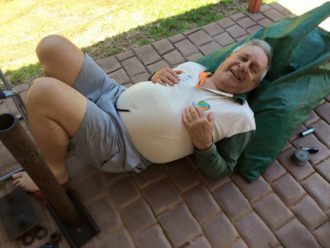 ******************
******************
Larry Niles, leader of Delaware Bay Shorebird Project, New Jersey
Clive Minton - A Loud Voice for Wildlife
Last year – and as it turned out it was the last of Clive's 23-year adventure in Delaware Bay working on shorebirds – we talked about death while driving to Baycove Beach. It's hard to avoid talk of death, given the aging of our team, many of whom have returned year after year for 23 years. In fact it is really shocking to see the slow ravage of time on our team every May! We headed for Baycove Beach to count shorebirds, check out the crab spawn and look for a place to cannon net, as we did every morning just after dawn. Clive said he didn't fear death because he loved his life, his family, his work, his passion for wildlife. He said he had no regrets in his long life, from his childhood in the Blitz onward. As he said this, he reached outside the truck, snatched a branch of honeysuckle which lined the private dirt road. He took a deep breath. He looked forward to the honeysuckle flowering on this road every year he came. He waited for it through the month and knew exactly when it began to flower. He took the sprig of honeysuckle and put it into a glass of water back at Reed's house. I wonder now if that is why he had no regrets in life because he always found something to appreciate wherever he went. He liked to catch birds, we all know that, and we also know he loved the birds he caught. He liked to chow down on a plate of greasy fried clams at Higbee's or a big slab of beef provided by one of Jane Galetto’s cooks. He also wanted to see the wild turkeys along back roads of the Bay. He always made a point of greeting the old locals like Smokey, the owner of Smokey’s Marina, at Reeds Beach. We did this every year. I know Clive did not choose this tragedy, and I pray that Pat and Irma recover fully. Thankfully he didn't have to suffer in his fatal accident. Cold comfort for all those who loved him as I do. But this lesson – take pleasure wherever you are – changed my life. It started when Clive came to Delaware Bay just when he was needed. By the end of that first year 1997, he helped convince then-Governor Whitman to get the fishermen to stop the uncontrolled killing of horseshoe crabs. And he came every year after to help us get it back on track. We did, thanks to his help. Last year he got to see the biggest flock of Red Knots since that first year. After that first year with Clive, my life took a right angle, more a course correction than a new turn. Whatever I was as a biologist, I was something else after my long collaboration with Clive (and Humphrey!). Clive loved birds enough to take action to help them. In one of the worst years on the Bay, we experimented with a network of thin lines over about an acre of beach to stop gulls from taking the few horseshoe crab eggs on Reeds Beach. It worked – well sort of. But here is the thing: at the heart of this action and the many others we took together to save shorebirds, was a genuine and abiding love for wildlife. It was a revelation. I came from a US version of wildlife management where animals existed in populations, and compassion for one animal went against the grain. You cannot manage a population worrying about the lives of just one animal. But Clive taught me, our team and anyone who happened to be on the beach for that matter, that protecting wildlife starts with compassion for a single animal. I think he knew this because his kind and gentle heart connected with the innocence of wildlife. When he held up a knot for a group of visitors to see, he spoke about the bird's life or its biology, but what came through to the people was a warm love for the birds; an admiration and concern, like that of a proud father for his child or an older brother for a young sibling. It's this love that makes us want to protect these animals whose only voice is people like Clive. I learned from Clive that we are all equals in God's creation (although he kept his views about God close to his chest). I learned that to protect wildlife, whether as a hunter, a cannon netter, or just an observer, one must see the beauty and innocence they represent first. He gave all of us who feel this way, profound experiences that filled life with more wonder, more action, and a much bigger reason to appreciate life. I will always remember and love Clive. ****************Birgitta Bueche & Edward Stubbings
We first met Clive in early 2015 when we joined the North-West Australia Wader Expedition in Broome. We immediately liked him. Who wouldn’t! Clive was extremely welcoming to us and we felt both exceptionally lucky and completely at ease working with him. He then invited us to come to Melbourne to help with wader and tern work. So for several weeks in 2016/17 we stayed with Clive and Pat in Beaumaris and spent Christmas with him and the family that year. The whole family were very hospitable and generous to us and we will never forget our Minton Christmas. We will remember Clive as funny, articulate, hard working and kind. The persistent contribution that he has made over so many years to the study of waders is staggering and his ‘The Father of Wader Studies’ title is well earned. He has done so much to further our understanding of waders and wader studies. Clive has been an inspiration to so many people, including ourselves, and will be sadly missed. Hopefully though, we will continue to be inspired by him as we further the work that he began in England all those years ago. A few funny memories that we have of Clive include:- We once sat in a 2m2 camouflaged hide with Clive waiting to fire a cannon net and were surprised to discover his method of emptying his bladder without leaving his chair or disturbing the birds on the beach. We will say no more.
- Another memorable occasion on our first trip to Australia was camouflaging a cannon net with cow dung whilst trying to catch Little Curlew and being directed in how to do this by Clive, who was sat nearby in a folding chair.
- During our stay at Beaumaris Clive and the family were kind enough to organise for us to go with them to see the first day of the test between Australia and Pakistan at the famous Melbourne Cricket Ground, or MCG. Being German, Bee had little knowledge of cricket and was amused by the fact that almost nothing happened during an entire days play. Even the Mintons agreed that this had been a particularly dull days cricket.
- The Christmas dinner that we had that year has to be one of the most memorable we have ever had. It began with the Turkey catching fire on the barbeque and continued with the fish monger supplying twice as many oysters as we had ordered, or anyone could possibly eat. I have never eaten so many oysters before or since.
- One of our funniest memories of Clive was when we were sitting in his home at Beaumaris whilst Clive was talking to someone on the phone. Clive often had a little nap at some point during a working day and we could see Clive becoming a bit tired. The scene became funnier and funnier as we watched Clive slowly but surely fall asleep whilst the person on the phone continued talking through the ear piece.
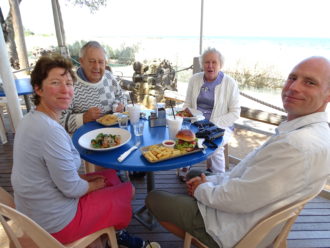 Bee (Birgitta Bueche), Clive, Pat and Ed.[/caption]
[caption id="attachment_13221" align="aligncenter" width="330"]
Bee (Birgitta Bueche), Clive, Pat and Ed.[/caption]
[caption id="attachment_13221" align="aligncenter" width="330"]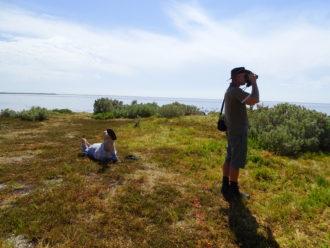 Clive and Ed counting waders.[/caption]
[caption id="attachment_13222" align="aligncenter" width="330"]
Clive and Ed counting waders.[/caption]
[caption id="attachment_13222" align="aligncenter" width="330"]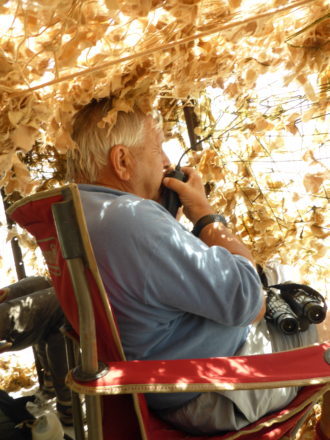 Clive in hide, Broome 2015.[/caption]
****************
Clive in hide, Broome 2015.[/caption]
****************
Amanda Dey, NJ Fish and Wildlife
It's hard to know where to start. I've known Clive Minton for 23 years and have seen him from two perspectives: A person who loves birds and invited anyone and everyone to feel free to love them too; and a person with the purpose and ingenuity to create a system to catch fast-flying shorebirds to study their migration ecology. Everyone who uses cannon nets learned from Clive, directly or indirectly. He fielded teams of like-minded folks, he taught and encouraged all comers, and spawned generations-long studies of migratory ecology in nearly all flyways. It's fair to say that much of what we know about the ecology of Artic-breeding shorebirds is because of Clive. Clive was not trained as an avian ecologist, but he knew as much or more than most professionals. There's a lot of ego and abstraction in the wildlife professions. Kindness is taken for weakness; concern for animals will get you labeled as an advocate and dismissed by most "professionals". Clive never shied from pointed discussion -- with anyone -- about the science of wild birds and was open about his motivation. Clive was a voice for animals that had no voice. He led in this way too because he was undeniably genuine. He taught generations – including many professionals – about how to catch birds and engage like-minded people in long-term studies. There is no other way to carry out such work – Clive understood this early on -- the rest of us are just catching on. The study of highly-migratory birds is one of the most difficult areas of ecology. Much of what we know is because of Clive and the people who gathered around him to catch shorebirds and carry out studies over the decades of his life. He taught me to act even when I'm afraid, to stand up for animals despite people's judgment, and be open to everything. I am grateful to Clive, his family, and colleagues who helped me/us be a strong, convincing voice for shorebirds and horseshoe crabs in Delaware Bay. ****************Yvonne Verkuil, Chair of the IWSG, University of Groningen, The Netherlands
Clive’s unexpected and tragic passing threw me off for days. That was quite surprising because Clive and I have never been much involved, even though I am involved in wader work for almost 30 years and fill one of his many footsteps being the current IWSG Chair. The reason is I don’t like catching birds. Get me well, I am not against it, and have colour-banded and blood-sampled many waders. Catching birds has tremendously improved our knowledge and conservation actions, and Clive has made lifelong worldwide contributions to this. But for me the increasingly nervous groups of birds being twinkled to the nets, the smell and sounds of birds waiting to be ringed in their keeping cages, and the worry about their wellbeing after their release, makes catching birds a professional chore at best. About two years ago again my job called me to a catching site, a real catching expedition in one of the most famous and exotic nonbreeding areas for waders: Roebuck Bay and Eighty Mile Beach in Broome, Australia. Clive started catching here in the 1980s, with the Australasian Wader Studies Group, and later also with Global Flyway Network. The expeditions are famous amongst waderologists. During the AWSG expeditions Clive involved local volunteers making them lifelong enthusiast for waders, and offered opportunities to international wader people to participate, mostly from other sites along the East Asian – Australasian Flyway. In Broome Clive has trained people from all over the world in wader catching and processing. I had heard the stories for years. I knew that sum totals of birds caught in a single AWSG expedition can run into the thousands and that Clive, in later years Chris Hassell of Global Flyway Network, lead these famous expeditions with military precision and attitude. The words “thousands” and “military” made me fear my own attitude, but I went. It was a lifelong wish to see those habitats after all. Surprisingly (or maybe not to you) I fell in love. Not only with the birds, but with Clive and Chris, both of them. If anyone need to catch so many birds, let it be Chris. I have never seen a team being more careful with keeping and releasing birds. It turned out that Chris and I saw eye to eye about many scientific and ethical concerns. And Clive, Clive was simply charming. Although not physically in charge anymore because his health did not allow it, his mind was on it. He exuberated enthusiasm and knowledge all day, was tirelessly involved in the catches and processing, even though walking was an issue. And yes, he could still burst out in a loud commanding voice, for example when he wanted us to reset a net. As expected, I was shocked and angered by his verbal fierceness and relentless twinkling, but at the same time I was charmed. This was wader history! And I was right there! In the evening I started taping his renowned after-catches speeches (about juvenile proportions) on my phone. Clive was also a wise and mild man, he knew exactly what I was thinking but did not put me in my place. May his spirit stay with us! [caption id="attachment_13121" align="aligncenter" width="330"]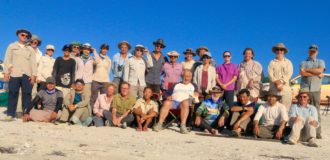 AWSG and GFN expedition Anna Plains, Eighty Mile Beach, February 2017. Credit: Robert Bush.[/caption]
****************
AWSG and GFN expedition Anna Plains, Eighty Mile Beach, February 2017. Credit: Robert Bush.[/caption]
****************
Graham Appleton, WaderTales, Norfolk, UK
I had not realised quite how much I would miss Clive, until the news of his untimely demise appeared on Skype, during a BOU Council meeting. We all knew that this day would come and it is now up to us to make sure that the world of shorebird research remains just as dynamic and full of fun, post-Clive. I met Clive in the English Midlands, as I gathered experiences to earn a BTO ringing permit. Canada Goose round-ups were fun, thrush roosts were interesting, swan-catching seemed a lot of effort but waders were something else. I first joined the WWRG on a trip in April 1974. We caught two birds but I was hooked, becoming a regular and training for a cannon-net licence. Had I not started wader-ringing I was probably destined to become an accountant. Given that school holidays coincided with the two summer Wash Weeks and opportunities to band shorebirds in James Bay with Guy Morrison, teaching seemed like a good alternative. It was a good choice and Clive provided a wonderfully perceptive reference. Getting to the Wash for a weekend trip, for me, involved bus, train and a walk up the hill to his Shenstone home. Here we witnessed the rapid change from besuited senior executive to chuckling, cannon-netting superhero, as the land-rover was loaded and we set off for a weekend of cannon-netting and mist-netting, and little sleep. Forty-eight hours later we would be back, having topped-and-tailed processing sheets in the car on the way back and fed Clive chocolate and tins of condensed milk to keep him awake. Clive was the first person to spot in me a capacity to get things done and even to lead. He convinced me to take responsibility for the WWRG’s paperwork, to swim from Snettisham to Wolferton Saltings, to twinkle waders, to co-write a paper about Lapwing moult, to cook for up to forty people and to learn how to become a scribe. In this latter role, I sat by his side and soaked up some of the immense knowledge that he so generously shared with other members of countless processing teams. Much of what I learned ‘at his knee’ underpins stories in WaderTales. Nobody had shown such faith in me before – or pushed me to such an extent. Two other cannon-net licensees from the seventies said the same sort of thing last week. Clive provided opportunity, support and encouragement - enabling people to grow. Yes - he was knowledgeable, inspirational, enthusiastic and passionate but his faith and interest in people set him apart. Although he will be sorely missed, his work will live on in the hundreds, perhaps thousands, of people that he recruited, taught and sent on their way, across the world. ****************John Goss-Custard, Lympstone, Devon, England
I was a shorebird behavioural ecologist when I first met Clive in the late 1960s. I belonged to the ‘low-tiders’ – shore-birders who got their data by observing foraging waders from the comfortable safety of a car parked alongside a narrow Devon creek or sitting uncomfortably – and sometimes dangerously – on a Boates’ box in the middle of some vast and apparently edgeless mudflat on the Wash. Clive, on the other hand, was a ‘high-tider’ whose data mostly came from birds caught at their high water roosts using techniques that he had played a large role in developing. Nowadays, this distinction is very much less marked than it was then and new research traditions have been accreted to serve our common purpose – remote-sensing, laboratory experiments, advanced statistics and physiology. The advances in understanding and predictive power that all these approaches have combined to produce is nothing short of incredible. Hypotheses can now be tested that would not even have occurred to us all those years ago. Clive contributed enormously to this scientific progress. I was very much a low-tider who really did not much enjoy ringing when I met Clive in the late 1960s, the first of only two or three occasions when our paths were to cross. It was on the Wash during a ‘wader weekend’. The contrast between my normal rather self-seeking and elitist working environment in academia and the one to which he introduced me could not have been greater. It was immediately apparent that Clive was a brilliant, inspiring leader of a group of (generally) highly cooperative and mutually-supporting enthusiasts, united by their common interest and admiration for him. He belonged to that category of men and women who change things: pioneers with tireless energy, massive intellect, infectious enthusiasm and a leadership style that made made things enjoyable and worthwhile for those around him, tempered by a necessary streak of ruthlessness in the service of the cause which fired him. I remember his humour, cheerfulness and general ‘joie de vivre’ that would not let him waste a moment that could be spent doing something worthwhile. I thought it incredible that a man with such a highly responsible job would drive to the Wash from the middle of England to spend the weekend, with little sleep, putting out nets, organising small armies of people, decision-making all the time and then returning to the Midlands to resume his job first thing on Monday morning. As a reading of Andrew Roberts’ recent biography of Churchill will show, Clive shared many of that remarkable person’s characteristics, though directed to a very different cause. When great people in Churchill’s world leave us, people fire off a lot of guns in their honour. Perhaps the cannon-netters of the World should unite to fire a massive, world-wide simultaneously-timed salvo to the great person who we have all just lost. ****************Grace Maglio, A Wader’s Life on Roebuck, Broome, NW Australia
Today we lost the godfather of Australian shorebirds. For me Clive was a constant source of inspiration and encouragement, especially through the really tough times. He was a great and irreplaceable leader who inspired so many; it is such a sad time. Clive, your constant words of encouragement and your faith in my abilities will continue to drive me forward. I will make you proud. Rest in Peace my dear friend. [caption id="attachment_13106" align="aligncenter" width="330"] The photo shows Clive surrounded by participants in the last NW Australia Expedition.[/caption]
****************
The photo shows Clive surrounded by participants in the last NW Australia Expedition.[/caption]
****************
Humphrey Sitters, UK
One of the most significant and positive events of my life was my first encounter with Clive Minton on The Wash in 1973. His boundless enthusiasm for waders, generosity, optimism and can-do attitude has had a profound influence on the course of my life, despite the fact that we have lived on opposite sides of the world for the past 40 years. But for Clive, I would never have developed a fascination for waders and the skills to catch them with cannon nets. That in turn led to my role helping to catch oystercatchers on the Exe estuary in support of the project led by John Goss-Custard from 1976 to 2004. Then in 1990 I left my previous profession as a lawyer, did a masters in ecology and a doctorate on night-feeding in oystercatchers with John G-C. In 1997, Clive asked me to join an expedition organised by Allan Baker to follow the northward migration of Red Knots from Argentina to Brazil and Delaware Bay. That was the first of more than 40 expeditions in which I have taken part to Delaware Bay and other key shorebird sites between Tierra del Fuego and the Arctic. I would have done none of these things but for Clive. And, but for Clive, I would never have edited the Wader Study Group Bulletin / Wader Study for 18 years from 2001 to 2018. And in between the above I have taken part in eight NW Australia expeditions including the thrill of counting 2.8 million Oriental Pratincoles in 2004, as well as cannon-netting at Werribee Sewage Farm and Corner Inlet in Victoria. And there are many others whose careers and lives have been changed in a good and positive way through association with Clive Minton. And then there’s the huge impact Clive’s life-work in waders has had on ecological science and conservation. It’s huge because he always worked as a team leader, and well-led teams can always accomplish far more than individuals. Clive may have had done a PhD in metallurgy, but above all he was a people-person, in fact most of his career was spent interacting with and managing people. And this was the key to his success in setting up and leading the Wash Wader Ringing Group, the (International) Wader Study Group, the Victorian Wader Study Group and the Australasian Wader Studies Group. He was certainly charming, but he also knew how to make people feel that their contributions were valuable and appreciated. Because of that people loved working with him, and were prepared to suffer all sorts of creature discomforts for him and the cause. He was also effective because he was generous in providing hard-won data to others to analyse and write-up. And that brings me to the reason why Clive is very much on my conscience at this time. From 2013 to 2016, I – with a lot of help and guidance from Magda Remisiewicz – carried out an analysis of all the southeast and northwest Australia adult wader moult data (a rather vast dataset!). But having completed the analysis (and given a talk about it to the IWSG conference) I couldn’t find the time to write the paper we had planned, and I still can’t though I should be able to do so soon. Therefore I absolutely promise you Clive that the paper will be written and published in Emu very soon! I have always had a lot of affection for Clive. It was fun to be in his company. But he wasn’t entirely perfect: he had a naughty streak; and the naughty streak was particularly prevalent in the presence of delicious food! ****************Roger Standen, Chair of the Victorian Wader Studies Group
The Father of Wader Studies - Tales of C.D.T. Minton
Clive Minton has been recognised with the first Victorian Wader Studies Group life membership and has his local and global contribution to wader studies have been documented in 2015 by Roger Standen in the book “The Father of Wader Studies”: [caption id="attachment_13094" align="aligncenter" width="330"] Standen, R. (2015). The father of wader studies: tales of C. D. T. Minton, 2015, 187 pp. https://www.vwsg.org.au/PDFs/Mintontales.pdf.[/caption]
***************
Standen, R. (2015). The father of wader studies: tales of C. D. T. Minton, 2015, 187 pp. https://www.vwsg.org.au/PDFs/Mintontales.pdf.[/caption]
***************
Frank O’Connor, Perth, Western Australia
Vale Dr Clive Minton: Where do you start?
I think I first met Clive at Broome Bird Observatory in 1992. He was an inspirational man. He certainly cemented my love of shorebirds, and as a result I have been a member of 20 or more North West Australia Wader Expeditions with Clive being involved in all of them (most as leader). He was the driving force that brought together people from all around the world who were interested in shorebirds. He was part of the group that discovered the enormous congregations of shorebirds in Roebuck Bay and 80 Mile Beach in about 1980, and was instrumental in getting the Broome Bird Observatory established. This is the place where I became hooked as a birder in July 1990 when Brice and Gail Wells were the wardens. Clive established the relationship with Anna Plains Station at 80 Mile Beach where half of our work on each expedition now takes place. It is an amazing place and I have so many memories of being there with Clive, such February 2004 when there were 2.8 million Oriental Pratincoles with an enormous plague of Yellow-winged Locusts. The tide line was covered with locust wings disgorged by the pratincoles as they spent the heat of the day on the mud flats. There were also large numbers of Oriental Plovers and Little Curlews at the same time. I have many indelible memories of NWA wader expeditions: camping on 80 Mile Beach (who left the shell on the stake when they returned from the toilet over the dunes?); camping on the edge of the Port Hedland saltworks (with clouds of mosquitos at dusk); sitting in the hide at 80MB with 49°C temperatures until the sea breeze came in just before high tide; and sitting in the hide during a torrential downpour as our 'directors chairs’ filled with water. Clive said he thought the rain was getting lighter. I replied that the dogs might have stopped but the cats were still falling! We were sitting in 4 inches of water! You always learn something new on every expedition: where shorebirds migrate or breed; a Sanderling only has three toes; wing moult; migration strategies; plumages. Clive's dedication to shorebirds is legendary and he has been widely recognised. He has a feather louse named after him. The Cryptic Forest Falcon in South America is named after him (Micrastur mintoni). Clive’s work ethic was enormous and he inspired everyone else involved. His legendary call of "Everybody must do something!" will always be remembered. I have so many memories of nearly 30 years involvement with Clive that I cannot remember them all. Next year's expedition will be very different without him. I do hope that Pat will make a quick recovery my condolences to his family. ****************Joanna Burger, Rutgers University, New Jersey
Clive will always live in the Knots that leave Delaware Bay each spring
Clive was a dear friend, and I will miss him forever. His love of life, of birds, of the world around him was a joy to watch, a joy to be part of, and a joy that we will always remember. I could, and no doubt will wax long about his many wonderful attributes and accomplishments, but it is the wonder of a man filled with joy and pleasure in everything and everyone around him that we will all miss each May. As the Knots arrive from the tip of South America, bound for the far north to breed, I will forever think of Clive. I will feel him with us as we sit on a wooden deck, watching the flocks take of in dense groups, making their way skyward, higher and higher, only to disappear in the blue sky, the dimming grey clouds, and the winds that will propel them north on an endless cycle of life. I will think of him always migrating with them, ever hopeful of a good breeding season, and another return to Delaware Bay. I first met Clive in Delaware Bay, but had known him and corresponded with him for many years before that. From my correspondence, I was little prepared for the man himself – a giant among wader folk, a man possessed with an ability to truly think about the lives of the birds. He was always the first to hug me when I arrived in Delaware Bay, and the last to kiss me good bye. Though I expected to see him next year, he hugged me extra long and hard this past May; and I shall always treasure that.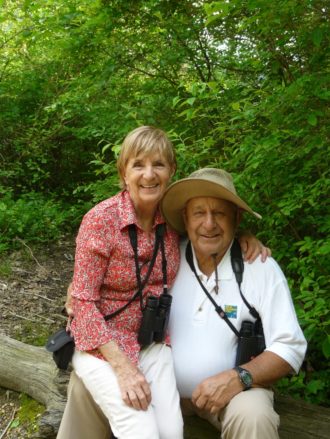 Delaware Bay, and the shorebirds, has been important to me from the first time I laid eyes on the masses of shorebirds in the 1980s. Then I walked the beaches alone, gazing at the birds. The human flock that arrives each year has grown. Larry, and then Mandy, have taken up the mantle of protecting the knots, joined ultimately by friends from all over the world. Together, we have seen lots of changes, and some improvements. Much of the enthusiasm and drive for the group has been Clive, with his smile and time for everyone.
When he came up to Rutgers for Mandy’s PhD defense, he was ecstatic, and so very happy for her success. He was like a fond father, gazing at her seminar, and appreciative of the work she had accomplished. So supportive of her, and of Larry’s efforts to keep the “team” together: it is this undying support and enthusiasm that we will all miss.
When we first began the geolocator work, Larry, Ron, and I found Clive’s help and support so important. His interpretations of what we were seeing were invaluable. His enthusiasm over the first google maps from our geolocator knots was infectious. The realization that we could know exactly where they were at all times overshadowed the difficulty of catching them. But he was always quick to search for knots with geolocators to catch, anxious for our net to swoop over them.
Delaware Bay, and the shorebirds, has been important to me from the first time I laid eyes on the masses of shorebirds in the 1980s. Then I walked the beaches alone, gazing at the birds. The human flock that arrives each year has grown. Larry, and then Mandy, have taken up the mantle of protecting the knots, joined ultimately by friends from all over the world. Together, we have seen lots of changes, and some improvements. Much of the enthusiasm and drive for the group has been Clive, with his smile and time for everyone.
When he came up to Rutgers for Mandy’s PhD defense, he was ecstatic, and so very happy for her success. He was like a fond father, gazing at her seminar, and appreciative of the work she had accomplished. So supportive of her, and of Larry’s efforts to keep the “team” together: it is this undying support and enthusiasm that we will all miss.
When we first began the geolocator work, Larry, Ron, and I found Clive’s help and support so important. His interpretations of what we were seeing were invaluable. His enthusiasm over the first google maps from our geolocator knots was infectious. The realization that we could know exactly where they were at all times overshadowed the difficulty of catching them. But he was always quick to search for knots with geolocators to catch, anxious for our net to swoop over them.
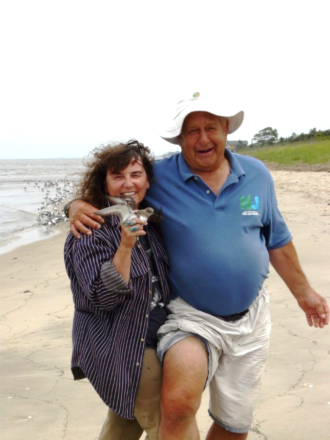 I loved being in banding groups with him, not only because he was knowledgeable, but seeing him with new volunteers was a treat. He loved creating excitement in the public, in students, in all of us. As the years passed, he ran more slowly to the birds trapped in the net, and finally he sat and watched these young volunteers run. But in our hearts, we will always see him running toward the net, hollering – “take care of the birds”
Last May, when we discussed next year’s shorebird work, he said “Of course I will be back.” Don’t you hate the long flights, I asked. “No, I love them; I get to sleep all the way.” And I believe he truly did for he was looking forward to yet another year with his beloved shorebirds, with Larry, Mandy and the shorebird crew, and with the “family” that meets each year on Delaware Bay. How will we enjoy the birds as much, the Horseshoe Crabs as much, or the food as much without Clive? We will all do so, because he lives on in all of us – for his spirit has inspired us all.
I loved being in banding groups with him, not only because he was knowledgeable, but seeing him with new volunteers was a treat. He loved creating excitement in the public, in students, in all of us. As the years passed, he ran more slowly to the birds trapped in the net, and finally he sat and watched these young volunteers run. But in our hearts, we will always see him running toward the net, hollering – “take care of the birds”
Last May, when we discussed next year’s shorebird work, he said “Of course I will be back.” Don’t you hate the long flights, I asked. “No, I love them; I get to sleep all the way.” And I believe he truly did for he was looking forward to yet another year with his beloved shorebirds, with Larry, Mandy and the shorebird crew, and with the “family” that meets each year on Delaware Bay. How will we enjoy the birds as much, the Horseshoe Crabs as much, or the food as much without Clive? We will all do so, because he lives on in all of us – for his spirit has inspired us all.
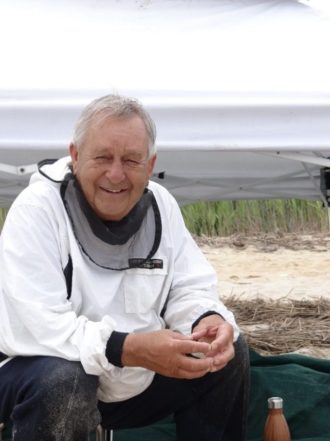 [caption id="attachment_13090" align="aligncenter" width="330"]
[caption id="attachment_13090" align="aligncenter" width="330"]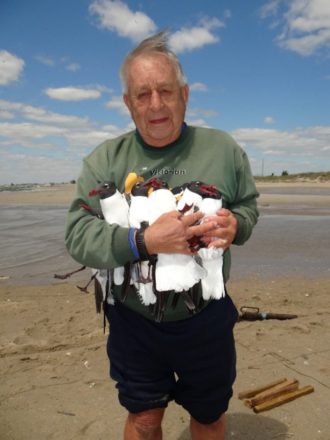 Clive Collecting Gulls for me.[/caption]
***************
Clive Collecting Gulls for me.[/caption]
***************
Rick and Elis Simpson, Wader Quest (UK wader charity)
What impressed us greatly about Clive Minton was how he was always ready to reach out and lend a helping hand to those who needed it. Wader Quest is a minnow in the world of wader conservation, yet Clive always answered our emails with a friendly kindness, in a way that showed that his care for and love of waders was far reaching. Clive encouraged anyone who would or could, become a champion of these wonderful birds to do so. He even took the time and trouble to write about how he was personally inspired, by a Sanderling on a beach in Northumberland, leading to a life of wader study, for our book An Inspiration of Waders, a kindness that we shall never forget. Clive was a great but humble man who touched the lives of many waderologists in a vast array of ways, and whose enthusiasm has rubbed off on so many others. The world is a better, safer place for waders thanks to this man’s dedication and passion. He will be greatly missed by many people involved in waders and their conservation around the world; even those of us who never had the privilege to meet him in person. ***************Mary Colwell, UK
Thank you, Clive, for everything you did for waders. You were like a wader yourself, never happier than in a flock, all working together. It was hard to say no to joining in, your endless enthusiasm, good humour, leadership, and at times delightful eccentricity were irresistible. You had us all scurrying around beaches and estuaries exploding nets, collecting birds, ringing, rushing about with cold drinks…some of my most treasured memories of living in Australia were ringing with you. You were always smiling, encouraging and positive. Your energy was legendary and I, for one, wish I had just a fraction of it. The world needed you Clive to bring waders in to the limelight – to shed light on their astonishing long-distance journeys around the earth. So light, so shy, so secretive, and yet you drew them out and showed us all just what tough creatures they are and what an extraordinary planet we live on. Thank you for all that. Maya Angelou’s words have never applied to anyone so well. “People will forget what you said, people will forget what you did, but people will never forget how you made them feel.” ****************Steve Gates, Princeton, New Jersey
I first got to know to Clive when we worked together trapping on Tierra del Fuego in the early 2000’s. Clive and several others had their tents blown down in the rain. He led us to move en masse into our big cook tent. Clive was completely unphased. Unphased? Nay, He was irrepressible! At breakfast and dinner he presided over the festivities wearing a bright red union suit. He sat on a rickety folding stool in that (I won’t say gross) red suit and held forth, first with several of the women leading the expedition on his knee. Next he put the men on his knee: Larry, Humphrey and even me. It was such a kick. We all forgot how wet and miserable we had been. I’ve had many experiences setting nets and going on reccies with him. I’ll let others tell about the confusing (yet inspiring) orders he shouted at us in the heat of getting birds out of the net. Not to mention everything he taught us about cannon netting and shorebirds. Being with Clive was always a delightful, if often nearly overwhelming, experience. ****************R.I. Guy Morrison, C.M., Government of Canada, Environment and Climate Change Canada, Ottawa, Ontario
Clive Minton … Some Memories
Along with many others, I can truly say that Clive Minton played an enormous and pivotal role in my life, my experiences with him on The Wash leading directly to a 38-year career (and counting!) doing shorebird research with Environment Canada. I was not always a birder or bander when young, but first came across Clive on the Wash in 1970. I was at Cambridge doing a Ph.D., when some of the leading lights of the Wash Wader Ringing Group learned that I was planning an expedition to Iceland (a long story in itself!) and suggested we turn it into a bird ringing expedition. This sounded most interesting, so I started going to the Wash to learn the techniques of cannon netting, under the tutelage of the renowned Clive Minton. Clive’s energy and enthusiasm were boundless, and our first visit to The Wash was memorable to say the least. Clive and the experienced members of the Group had set the cannon nets on the beach on a cold March day, ready for the evening tide. A large flock of knots gathered near the nets and it was not long before we heard the boom as two nets sailed over the flock in the gathering evening gloom. It was a Clive Special – there under the nets were over three thousand knots! Dealing with the birds took most of the night. It was bitterly cold, and Angela (my wife) and I, being newcomers, were lucky to be assigned the task of running the birds from the experienced extractors to the keeping cages, the exercise keeping us relatively warm – others, including Mike Pienkowski and Clive, were less fortunate, crouched in the icy (there was ice on the sea the next morning!) tide edge taking the birds out of the net. The catch was so large that the group ran out of rings, a situation solved by one person driving to Cambridge (about 1.5-2 hours each way) to get more. With Clive in charge, no wader that was caught was released without at least a ring! The date – “7.3.70” – was one that would later become engraved on my memory from the large number of recoveries resulting from the catch! Being new and naïve, we thought that when the mammoth task of dealing with over 3,000 birds was completed – taking most of the night - the group might rest on its laurels and perhaps forgo a catching attempt on the morning tide. Not so, of course, with Clive – off went the diehards to try their hand at mist netting. After our baptism of fire (or more appropriately, ice) I remember asking someone if Wash weekends were always like this … I cannot remember if the response was laughter or eye-rolling or headshaking, but of course catching can never be guaranteed! Clive’s wife Pat and their two sons (aged about 8 and 10?) often accompanied him on Wash weekends and the Wash Week campaign in August: Pat commanded equal respect as Clive, if not more so! Occasionally I would give the two boys a ride in our Volkswagen beetle, which had a sun-roof … we would race down the farm tracks, the boys with their heads out the roof, enjoying the “wild” ride. Apparently, they all remember those rides – I have been reminded several times recently by both Clive and Pat, as well as Roger, who recently visited us in Ottawa and said he had done the same thing with his own sons! Pat was involved in another memorable story when we were attempting to make a catch on the ploughed fields behind the seawall, where huge flocks of waders would roost at high tide. Clive and the team had set two lines of cannon nets, firing towards each other, a very effective method for birds between the nets. A massive flock of Dunlin had gathered, just outside the catching area, of course, and we were twinkling the birds using Clive’s Land Rover. Vehicles are sometimes more effective than people for twinkling, and we were really close to the birds, needing just one little “push” to get them into the area. It was a cold day, and as the tension rose, and the breathing became heavier, the inside windows of the vehicle started to steam up. Without thinking, Pat picked up a white handkerchief or cloth and started vigorously wiping the front windows to clear the condensation … at which point, the birds in front of the Land Rover took off with an explosive roar of wings. For once, Clive was left speechless, while we in the back tried not to break the awkward silence with an ill-timed guffaw!! Our apprenticeship with the WWRG proceeded over the next two years, and I ended up organizing expeditions to Iceland to catch waders in 1970, 1971, and 1972, the final one lasting six months and covering spring and autumn migration as well as the breeding season in Iceland. Clive could not have been more helpful or encouraging and the ringing results showed clearly that the knots that spent the wintering in the UK and Europe were the ones breeding in Greenland and the Canadian Arctic. After Cambridge, I ended up with academic qualifications and fairly considerable experience with field studies of waders and was fortunate in landing on my feet when I was offered a job to do research on shorebirds for the Canadian Wildlife Service. Even there, there was a Wash connection involving Clive, as it was Hugh Boyd whom I had met on the Wash (and who brought the Wildfowl Trust rocket nets to the Wash at Clive’s request) who drew my attention to the Canadian job opportunity. I soon realized that Clive was the sort of person who routinely fitted eight days of work into the normal seven-day week. And soon learned that when Clive asked you to do something, there was no question about whether you would do it or not! This effect lasted for many years: I recall Clive contacting me from Australia after I had worked for the Canadian Wildlife Service for some time, with the request that could I send him ALL of the North American banding recoveries for ALL shorebirds for a talk he was preparing. Without hesitation I thought and responded, “Of course Clive, will next week be OK?”. Clive and his family moved to Australia in 1978, where I imagined him taking the Australian wader scene by storm … which he clearly did! It was some 30 years later before I saw him again, this time on the shores of Bahia Lomas in Tierra del Fuego, Clive and Humphrey Sitters being part of Larry Niles’ team catching knots. In more recent years, I have had the pleasure of seeing Clive each spring in Delaware Bay. While a little less physically robust than in earlier years, Clive’s enduring enthusiasm, energy and wealth of knowledge always made him a pleasure to be around. I remember one incident with particular affection, one described in Roger Standen’s 2015 account of Clive’s life, in which Clive and I suffered something of a tongue-lashing from Larry during a dramatic catch in Delaware Bay. After much effort, a rather large sample of knots had been trapped, more than the desired quota, which I had not realized. As we were clearing the last of the birds from the net, we ran out of keeping cages, though I could see some empty ones being carried back down the beach towards the nets. Larry announced something to the effect “OK, let the rest of the birds go” – thinking of Clive’s golden rule that anything that was caught should at least be ringed (see my first catch on The Wash above!) and with Clive just nearby, I had the temerity to ask “Larry, are you sure?”. Clive also questioned the order, and we were both rewarded with an angry instruction to do as we were told, in no uncertain terms. From my own experience, I quite understood how such things happen in the heat of the moment during a catch … and did as I was told! We sorted it all out afterwards in a friendly fashion … and I could not help thinking it would make a great entry on my CV – “Clive Minton and I received royal chewing out from Larry Niles during Delaware Bay catch” – I could hardly have been in better company! I have to say I have been very touched by Clive’s friendship during the Delaware Bay work in recent years, a sense of companionship probably reflecting the fact that we have known each other for the better part of fifty years. And Clive was more than kind to my wife Susan (whom I had married after Angela passed away). Sitting with Clive on the deck of the house on Reed’s Beach towards the end of May as the flocks of shorebirds gathered and headed off on the evening tide, bound for the Arctic, is a treasured memory. At the end of last May, as we prepared to depart Delaware Bay, we would say to Clive “Look forward to seeing you next year”. And Clive would reply “Yes, I am planning to come, if I don’t fall off my perch before then”. A graphic birdy image imbued with Clive’s sense of humour – the perch may appear to be empty now, but we know Clive’s spirit is still there, and will be with us until we too fall off our own perches. [caption id="attachment_13092" align="aligncenter" width="330"]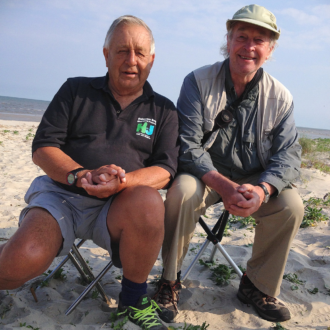 Clive and Guy Morrison, Delaware Bay 2015.[/caption]
[caption id="attachment_13096" align="aligncenter" width="330"]
Clive and Guy Morrison, Delaware Bay 2015.[/caption]
[caption id="attachment_13096" align="aligncenter" width="330"]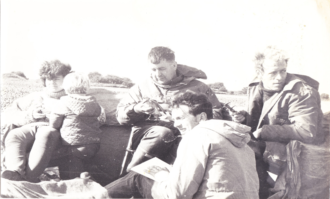 Clive on The Wash in the early 1970s. Daphne Watson (with child) is to Clive’s right on the left of the picture.[/caption]
[caption id="attachment_13085" align="aligncenter" width="330"]
Clive on The Wash in the early 1970s. Daphne Watson (with child) is to Clive’s right on the left of the picture.[/caption]
[caption id="attachment_13085" align="aligncenter" width="330"]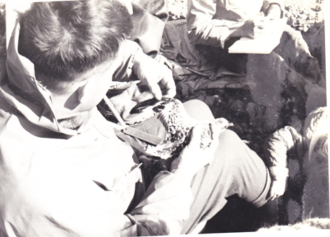 Clive processing a Grey Plover, The Wash, early 1970s.[/caption]
Clive processing a Grey Plover, The Wash, early 1970s.[/caption] Tributes and remembrances page for Clive Minton
This is the Tributes and Remembrances page for Clive Minton. Members are asked to send their memories of Clive to chair@waderstudygroup.org for publication on the website. **************** Tribute to Clive from Mike Pienkowski from the 2020 AGM - https://www.dropbox.com/s/xsk0y76xfmmfu6m/MikeOnClive2.mp4?dl=0 Video of the memorial service in three sections (password for each one is Minton): https://www.belindajanevideo.com/client-video/clive-minton/ **************** John Edwards -
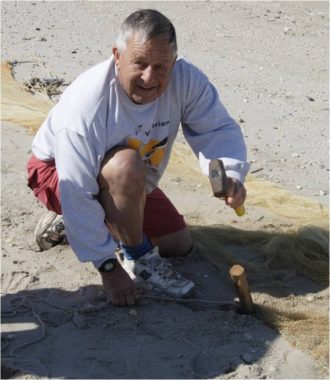 Featured image: Waders in flight, 2006 Delaware Bay (Simon Gillings).
Featured image: Waders in flight, 2006 Delaware Bay (Simon Gillings). Death of the International Wader Study Group’s founding father, Dr Clive Minton
We are very sad to report the death of the International Wader Study Group’s founding father, Dr Clive Minton, in a car accident in Victoria, Australia, on 6 November 2019. Clive was returning home after a trip to see birds on Kangaroo Island in South Australia along with his wife, Pat, and another lady, Irma Kluger. Both ladies were badly injured and are now recovering in hospital. Our thoughts are very much with Pat and Irma and their families at this difficult and sad time. Clive Minton’s
Postdoc Movement Ecology: “Studying the causes of shorebird movement and habitat selection” | NIOZ
The department of Coastal Systems (COS) is looking for a highly motivated Postdoc. We offer a postdoctoral position of maximally 3 years on movement and spatial ecology of shorebirds under the supervision of Dr. Allert Bijleveld. This project is part of ongoing research on understanding how individual differences, sociality and the distribution of resources affect movement and spatial distributions of shorebirds in the Dutch Wadden Sea. LOCATION: ROYAL NIOZ TEXEL (THE
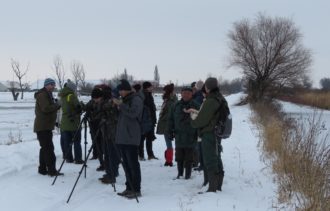 Crispy morning in NP Hortobagy – a field excursion during II. ÉLVONAL conference in January 2019. Photo: Vojtěch Kubelka.[/caption]
Featured image: Masked Lapwing (Vanellus miles) during aggressive nest defence above tropical grasslands in Daintree NP, Australia. Photo: Vojtěch Kubelka.
Crispy morning in NP Hortobagy – a field excursion during II. ÉLVONAL conference in January 2019. Photo: Vojtěch Kubelka.[/caption]
Featured image: Masked Lapwing (Vanellus miles) during aggressive nest defence above tropical grasslands in Daintree NP, Australia. Photo: Vojtěch Kubelka.
III. ÉLVONAL Conference and Demographic workshop | 10–19 January 2020 Debrecen, Hungary
ÉLVONAL Shorebird Science (elvonalshorebirds.com) is happy to announce the III. ÉLVONAL conference during 10–12 January 2020 in Debrecen (Hungary) followed by workshop „Modeling population dynamics: Estimating demographic parameters for wildlife conservation“ in the same venue during 13–19 January 2020 led by Brett Sandercock. Find more details here: III. ÉLVONAL CONFERENCE – III.ELVONAL conference flyer DEMOGRAPHIC WORKSHOP – Demography Workshop December 2020 details Both
Wader Quest Inspiration of Waders Day & AGM | 27 October 2019, Norfolk, UK
For the first time ever Wader Quest is holding an event to support its AGM, "come along and be inspired". There will be a number of speakers discussing a variety of wader-related subjects. Come along and buy your Wader Quest goodies and meet the team. Second-hand wildlife and science books will be on sale. Buy your copy of An Inspiration of Waders by Rick and Elis Simpson. Times Doors open at 10.00; talks start at 10.30 Lunch 12.00 (Bookable in the centre on the day) AGM at 13.00 Talks resume
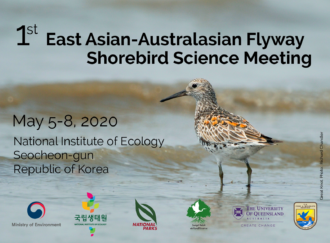 Featured image: Pacific Golden Plover, 5th may 2018, Lady Elliot Island, Queensland, Australia (c) P. Kavanagh on flickr
Featured image: Pacific Golden Plover, 5th may 2018, Lady Elliot Island, Queensland, Australia (c) P. Kavanagh on flickr 1st East Asian-Australasian Flyway Schorebird Science Meeting | May 5-8 2020 Seocheon-gun, Republic of Korea
Save the Date! The 1st East Asian-Australasian Flyway Shorebird Science Meeting to be held at the National Institute of Ecology, Seocheon-gun, Chungcheongnam-do, Republic of Korea, 5-8 May 2020. The 1st East Asian-Australasian Flyway (EAAF) Shorebird Science Meeting will be held at the National Institute of Ecology, Seocheon-gun, Chungcheongnam-do, Republic of Korea (May 5-8, 2020). This meeting will support international efforts to study, monitor, and conserve migratory shorebirds.
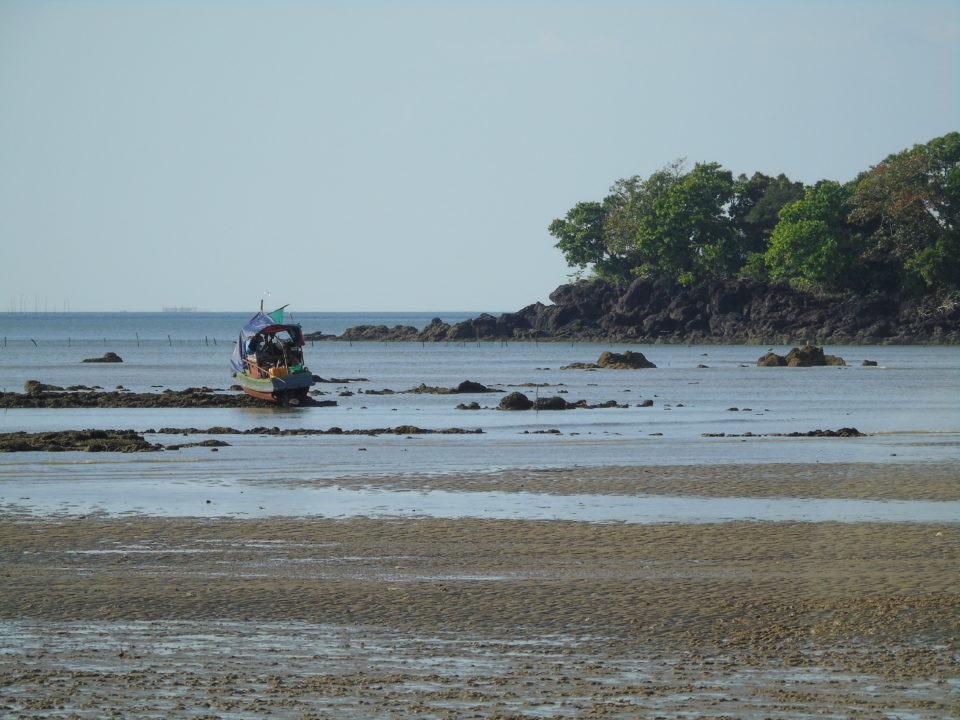 The landscape of the Myeik Archipelago and one of the boats used for fieldwork. (photo: Christoph Zöckler)[/caption]
Why did it take so long for this area to be surveyed? There are numerous reasons, but two practical ones are that the area is remote and there was a lot of area to cover. The region surveyed by Zockler and colleagues covered 620,000 hectares. To give some context, a perfect square-shaped hectare is 100 metres on every side. The grassy area inside a 400-metre running track is typically just over a hectare. Now imagine 620,000 running tracks or an area about the size of the state of Delaware. Now take that area and stretch it out in a narrow 5–10 km band of mangrove and mudflat about 250 km long.
It took eight separate surveys, conducted from December 2013 to November 2017, to cover the area and some key areas were surveyed repeatedly. Much of the area is covered with mature mangrove forest and is largely untouched by human interference. It must have been beautiful to see, but some parts of it were difficult to access for study. The intertidal flats consist of deep mud that is impossible to walk on. Local people use wooden sledges to move around, but that was impractical for large scale surveys. Instead, the researchers used small boats, most about 9 meters in length. These boats were sturdy enough to cross larger areas of water, even during rough seas, but still small enough to access shallow areas with shallow water.
The landscape of the Myeik Archipelago and one of the boats used for fieldwork. (photo: Christoph Zöckler)[/caption]
Why did it take so long for this area to be surveyed? There are numerous reasons, but two practical ones are that the area is remote and there was a lot of area to cover. The region surveyed by Zockler and colleagues covered 620,000 hectares. To give some context, a perfect square-shaped hectare is 100 metres on every side. The grassy area inside a 400-metre running track is typically just over a hectare. Now imagine 620,000 running tracks or an area about the size of the state of Delaware. Now take that area and stretch it out in a narrow 5–10 km band of mangrove and mudflat about 250 km long.
It took eight separate surveys, conducted from December 2013 to November 2017, to cover the area and some key areas were surveyed repeatedly. Much of the area is covered with mature mangrove forest and is largely untouched by human interference. It must have been beautiful to see, but some parts of it were difficult to access for study. The intertidal flats consist of deep mud that is impossible to walk on. Local people use wooden sledges to move around, but that was impractical for large scale surveys. Instead, the researchers used small boats, most about 9 meters in length. These boats were sturdy enough to cross larger areas of water, even during rough seas, but still small enough to access shallow areas with shallow water.
 Four to six shorebird observers worked and slept on these study boats along with a boat operator. In areas too shallow for the 9-meter boats to enter, the researchers used 3-meter fishing boats, hired on site, which carried two observers plus a driver.
Beyond the boats, binoculars and spotting scopes were needed to survey and identify the birds to the species level. Digital cameras were also used to capture images that could be magnified to identify species. Finally, modern technology was used to tag bird records with GPS coordinates through a mobile phone application.
The researchers recorded more than 35,000 water birds and point out that the Myeik archipelago might support even higher numbers since they were not able to visit all sites suitable for water birds in the survey area. Still, the surveys were enough to show that certain areas of the site are particularly important. For example, Sakhan Thit in the north and Bokpyin in the south alone hosted over 25,000 water birds, including several globally near-threatened species. The Bokpyin area had the highest concentration of globally red-listed species, and all six globally threatened species occurred there – some in significant numbers. For example, up to 60 of the globally endangered Nordmann’s Greenshank Tringa guttifer were counted during the study period. The critically endangered Spoon-billed Sandpiper Calidris pygmaea was found at two sites. One Far-Eastern Curlew Numenius madagascariensis was observed among a flock of almost 2,000 Eurasian Curlews in the Bokpyin area – the first record of this species for Myanmar. Finally, a Crab Plover Dromas ardeola was observed among a flock of over 100 Gull-billed Terns north of Bokpyin, only the second record for Myanmar.
The Myeik archipelago is clearly important, but it is also under threat. Coastal development is the biggest danger because the archipelago is close to the booming city of Myeik. The southern town of Bokpyin is likely to expand too, threatening intertidal mud and sandflats, as well as the mangroves north and south of town. Hunting is another potential threat. Villagers in the area report that hunters set up their traps whenever there are flocks of about 1000 water birds.
What is really needed is formal protection for the region. The authors propose the creation of Ramsar sites within the area and the results of their research justify this designation. According to the Ramsar convention, any wetland which meets at least one of the Criteria for Identifying Wetlands of International Importance can be designated by the appropriate national authority to be added to the Ramsar List3. The surveys show that the Myeik archipelago meets four of the nine Ramsar criteria.
Four to six shorebird observers worked and slept on these study boats along with a boat operator. In areas too shallow for the 9-meter boats to enter, the researchers used 3-meter fishing boats, hired on site, which carried two observers plus a driver.
Beyond the boats, binoculars and spotting scopes were needed to survey and identify the birds to the species level. Digital cameras were also used to capture images that could be magnified to identify species. Finally, modern technology was used to tag bird records with GPS coordinates through a mobile phone application.
The researchers recorded more than 35,000 water birds and point out that the Myeik archipelago might support even higher numbers since they were not able to visit all sites suitable for water birds in the survey area. Still, the surveys were enough to show that certain areas of the site are particularly important. For example, Sakhan Thit in the north and Bokpyin in the south alone hosted over 25,000 water birds, including several globally near-threatened species. The Bokpyin area had the highest concentration of globally red-listed species, and all six globally threatened species occurred there – some in significant numbers. For example, up to 60 of the globally endangered Nordmann’s Greenshank Tringa guttifer were counted during the study period. The critically endangered Spoon-billed Sandpiper Calidris pygmaea was found at two sites. One Far-Eastern Curlew Numenius madagascariensis was observed among a flock of almost 2,000 Eurasian Curlews in the Bokpyin area – the first record of this species for Myanmar. Finally, a Crab Plover Dromas ardeola was observed among a flock of over 100 Gull-billed Terns north of Bokpyin, only the second record for Myanmar.
The Myeik archipelago is clearly important, but it is also under threat. Coastal development is the biggest danger because the archipelago is close to the booming city of Myeik. The southern town of Bokpyin is likely to expand too, threatening intertidal mud and sandflats, as well as the mangroves north and south of town. Hunting is another potential threat. Villagers in the area report that hunters set up their traps whenever there are flocks of about 1000 water birds.
What is really needed is formal protection for the region. The authors propose the creation of Ramsar sites within the area and the results of their research justify this designation. According to the Ramsar convention, any wetland which meets at least one of the Criteria for Identifying Wetlands of International Importance can be designated by the appropriate national authority to be added to the Ramsar List3. The surveys show that the Myeik archipelago meets four of the nine Ramsar criteria.
- The area harbours rare species including six globally threatened and nine near-threatened water birds.
- The area supports critical life cycle stages of species such as the Lesser Adjutant Stork Leptoptilos javanicus, which nests in all five sections of the surveyed area.
- The area supports more than 20,000 water birds (numbers from all five survey sections amount to over 35,000 waders, gulls, terns, egrets and herons).
- Finally, the area supports more than 1% of a global flyway population for several species as outline in Table 4 of the paper.
Spotlight: Monitoring shows the importance of Myeik Archipelago, Myanmar
Shorebirds have been intensively studied in some parts of the world, but much less so in other areas. Take Myanmar, for example: this country in southeast Asia has a continuous coastline of almost 3,000 km. It is a place with abundant intertidal mudflats and mangroves, yet, the importance of this country’s coastal wetlands was not documented until 20141. Even after the significance of this coastline was known, few of the intertidal sites or mangroves had any formal protection, in part because
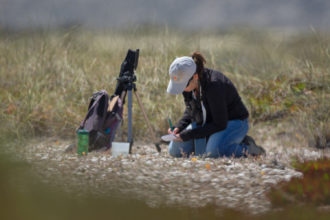 ©Darío Podestá. 2016 IWSG Small Project Grant winner, Glenda D. Hevia collecting data from Two-Banded Plover nests during fieldwork at Península Valdés, Patagonia Argentina.[/caption]
Featured image: ©Jannik Hansen
©Darío Podestá. 2016 IWSG Small Project Grant winner, Glenda D. Hevia collecting data from Two-Banded Plover nests during fieldwork at Península Valdés, Patagonia Argentina.[/caption]
Featured image: ©Jannik Hansen The IWSG Small Project Grant call is now open
The IWSG Small Projects Grants aim to support shorebird studies that otherwise will not go ahead. This could be all sorts of projects related to waders (shorebirds): ecological and/or conservation research, pilot studies looking at biological aspects of a single or a few species, or counts of staging birds at unexplored sites. Or something completely different! Application is open for IWSG members who have a project idea that could be undertaken if supported with a small amount of money
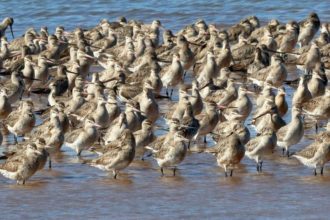 Bar-tailed Godwits roosting at Moreton Bay. ©Chris Walker.[/caption]
Featured image: Far-Eastern Curlew ©Duade Paton.
Link to a short ABC News video about the Queensland Toondah Harbour Development there: https://youtu.be/BxL62EPIgPA
Bar-tailed Godwits roosting at Moreton Bay. ©Chris Walker.[/caption]
Featured image: Far-Eastern Curlew ©Duade Paton.
Link to a short ABC News video about the Queensland Toondah Harbour Development there: https://youtu.be/BxL62EPIgPA “Marina plan threatens to destroy final stronghold of Endangered curlew” | sign the petition
Moreton Bay in Queensland, Australia, is widely recognized as an important site for shorebirds in the East Asian–Australasian Flyway with 23 migrating species regulary occuring on and one of the largest populations of the ‘Critically Endangered’ Far-Eastern Curlew in Australia. The bay also welcome internationally significant numbers of Whimbrel, Bar-tailed Godwit, Lesser Sand-Plover, Curlew sandpiper, Grey-tailed Tattler, Red-Necked Stint and Pacific Golden Plover. This Ramsar site is

